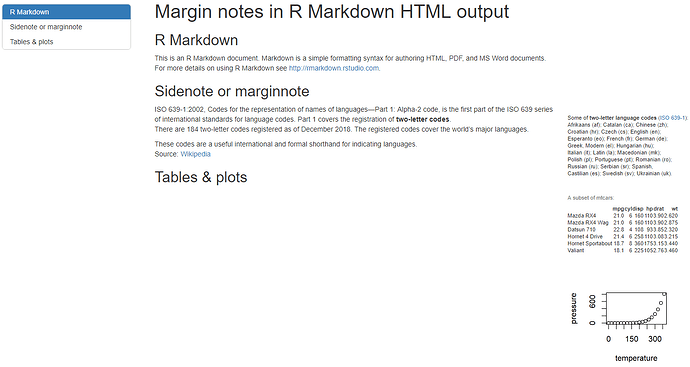Hi,
As far as I know, those Tufte/Tint distinctive features: sidenotes, marginnotes and marginfigure are possible due to predefined wide margin configuration. In R Markdown (HTML output) that "extra space" is "reserved" to toc: ; but this doesn't restrict us to play around with code and margins.
I was able to reproduce marginnotes and marginfigure (or something that looks alike ![]() ) with HTML&CSS (credit goes to @crumpmj, see this post and solution here) and failed to reproduce the
) with HTML&CSS (credit goes to @crumpmj, see this post and solution here) and failed to reproduce the sidenote mark (the superscript number).
Is the following workaround helpful to you?
Here goes the reproducible .Rmd:
---
title: "Margin notes in R Markdown HTML output"
output:
html_document:
toc: yes
toc_depth: 3
toc_float:
collapsed: yes
smooth_scroll: yes
---
```{css sidenote, echo = FALSE}
.sidenote, .marginnote {
float: right;
clear: right;
margin-right: -60%;
width: 57%; # best between 50% and 60%
margin-top: 0;
margin-bottom: 0;
font-size: 1.1rem;
line-height: 1.3;
vertical-align: baseline;
position: relative;
}
```
```{r setup, include=FALSE}
knitr::opts_chunk$set(echo = FALSE)
```
## R Markdown
This is an R Markdown document. Markdown is a simple formatting syntax for authoring HTML, PDF, and MS Word documents. For more details on using R Markdown see <http://rmarkdown.rstudio.com>.
## Sidenote or marginnote
ISO 639-1:2002, Codes for the representation of names of languages—Part 1: Alpha-2 code, is the first part of the ISO 639 series of international standards for language codes. Part 1 covers the registration of **two-letter codes**. <div class="sidenote">Some of **two-letter language codes** (<a href = "https://en.wikipedia.org/wiki/ISO_639-1" target="_blank">ISO 639-1</a>):</div>
<div class="marginnote">Afrikaans (af); Catalan (ca); Chinese (zh); <br> Croatian (hr); Czech (cs); English (en); <br> Esperanto (eo); French (fr); German (de); <br> Greek, Modern (el); Hungarian (hu); <br> Italian (it); Latin (la); Macedonian (mk); <br> Polish (pl); Portuguese (pt); Romanian (ro); <br> Russian (ru); Serbian (sr); Spanish, <br> Castilian (es); Swedish (sv); Ukrainian (uk).</div>
There are 184 two-letter codes registered as of December 2018. The registered codes cover the world's major languages.
These codes are a useful international and formal shorthand for indicating languages.
Source: [Wikipedia](https://en.wikipedia.org/wiki/ISO_639-1)
## Tables & plots
<div class="marginnote">`r knitr::kable(mtcars[1:6, 1:6], caption = 'A subset of mtcars:', format = "html", linesep = "")`</div>
<div class="marginnote">
```{r pressure, fig.height = 2.5, fig.width = 2.5, echo = FALSE}
plot(pressure)
```
</div>
Output:
